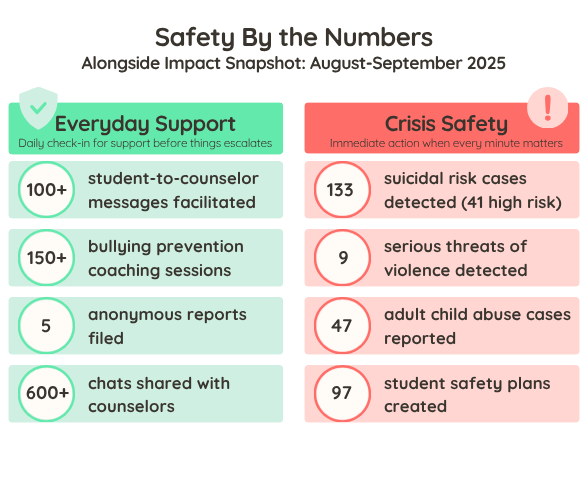
The STOP School Violence Grant Program from the U.S. Department of Justice’s Bureau of Justice Assistance (BJA) is one of the largest federal funding opportunities for improving student safety. In FY25, more than $83 million will be awarded to help schools prevent violence, bullying, and self-harm.
For district administrators, this is a chance to secure up to $1 million over three years to strengthen your safety strategy, support your threat assessment teams, and introduce technology that helps students ask for help before crises escalate.
What the STOP Grant Funds for Districts
The program is designed specifically to help K–12 districts:
- Train staff and students to recognize warning signs, de-escalate bullying, and respond to crises (including suicide prevention).
- Establish or strengthen Behavioral Threat Assessment and Management (BTAM) teams that coordinate administrators, counselors, law enforcement, and mental health staff.
- Implement technology solutions, such as anonymous reporting tools or other school safety technologies.
🚫 What STOP funds cannot cover: hardware-based “target hardening” (e.g., cameras, locks, metal detectors) or hiring school resource officers.
Key Application Deadlines
- Grants.gov (SF-424): October 27, 2025
- JustGrants full application: November 3, 2025
- Performance period: 36 months, beginning October 2025
What District Leaders Need to Prepare
To be competitive, district applications should:
- Demonstrate local need. Use your district’s own data on bullying incidents, threat reports, suspensions, or self-harm to show urgency.
- Set clear goals. Examples: “Train 95% of staff in crisis response” or “Reduce average time from report to intervention by 20%.”
- Strengthen BTAM processes. Document your team structure, referral pathways, and how you’ll partner with law enforcement.
- Add a technology layer. Show how digital tools will help students report concerns, support staff, and reduce violence.
- Protect student privacy. Include FERPA-compliant data-sharing plans and safeguards against discrimination.
- Plan for sustainability. Identify how the program will be maintained after the 3-year grant ends.

How Alongside Strengthens Your STOP Proposal
Alongside is a district-ready platform that directly supports STOP objectives:
- Live Training: Clinician-led professional development equips educators and staff with the knowledge and tools to identify, understand, and prevent suicide, mental health concerns, and substance use challenges.
- Self-guided coaching: On-demand coaching modules help students and staff learn emotional regulation, bullying prevention, and crisis response skills.
- BTAM Support: Provides FERPA-compliant insights and early signals to help teams identify risks and intervene sooner.
- Anonymous Messaging: Students can send confidential notes directly to school counselors, lowering barriers to help-seeking and providing a 24/7 anonymous reporting system.
By combining training, BTAM enablement, and an anonymous reporting feature, Alongside strengthens the core of a STOP application while also providing measurable outcomes for safety and climate improvement.
Alongside Safety Impact by the Numbers
In just the first two months of the 2025-26 school year with many partners still yet to launch for the year, Alongside is already making a huge impact by helping to identify severe issues while providing everyday support to help prevent problems from escalating in the first place. This chart summarizes key data from our partners that have launched so far this Fall. With more students and schools coming onto the platform every day, these numbers are constantly increasing.
Next Steps for District Leaders
- Engage your BTAM team and law enforcement partners now to draft letters of support.
- Collect your local safety and discipline data to establish the need in your narrative.
- Connect with technology and training partners like Alongside to scope deliverables and budgets.
- Draft your 36-month implementation plan with a clear timeline for training, team development, and technology rollout.
Ready to Apply?
The STOP School Violence Program is a competitive but powerful way to expand your district’s safety strategy. With $83M available nationwide, districts that demonstrate local need and propose comprehensive prevention strategies are well-positioned to succeed.
👉 Schedule a meeting to learn how we can help you design a STOP-aligned proposal that protects students, strengthens BTAM teams, and builds safer school communities.



